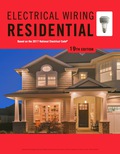instal second heater, and what is the minimum size circuit breaker that can be used if this is a continuous-duty circuit? hat will be the circuit cu rent arter inst ation of the 3. You are an electrician. You have been asked by a homeowner to install a lighted mirror in a bathroom. The mirror contains eight 40-watt lamps. Upon checking the service panel you discover that the bathroom circuit is connected to a single 120-volt, 20-ampere circuit breaker. At present, the circuit supplies power to an electric vwall heater rated at 1000 watts, a ceiling fan with a light kit, and a light fixture over the mirror. The fan motor has a full-load current draw of 3.2 amperes and the light kit
instal second heater, and what is the minimum size circuit breaker that can be used if this is a continuous-duty circuit? hat will be the circuit cu rent arter inst ation of the 3. You are an electrician. You have been asked by a homeowner to install a lighted mirror in a bathroom. The mirror contains eight 40-watt lamps. Upon checking the service panel you discover that the bathroom circuit is connected to a single 120-volt, 20-ampere circuit breaker. At present, the circuit supplies power to an electric vwall heater rated at 1000 watts, a ceiling fan with a light kit, and a light fixture over the mirror. The fan motor has a full-load current draw of 3.2 amperes and the light kit
Chapter3: Determining The Required Number Of Branch Circuits, Lighting Outlets, And Receptacle Outlets
Section: Chapter Questions
Problem 37R: In the past, it was common practice to connect the lighting and receptacle(s) in a bathroom to the...
Related questions
Question
Practical application 3, with attatchment page 2 pages,.

Transcribed Image Text:instal
second heater, and what is the minimum size circuit breaker that can be used if this
is a continuous-duty circuit?
will be the circ
lation of the
2 You are an electrician. You have been asked by a homeowner to install a lighted mirror
in a bathroom. The mirror contains eight 40-watt lamps. Upon checking the service
panel you discover that the bathroom circuit is connected to a single 120-volt,
20-ampere circuit breaker. At present, the circuit supplies power to an electric wall
heater rated at 1000 watts, a ceiling fan with a light kit, and a light fixture over the
mirror. The fan motor has a full-load current draw of 3.2 amperes and the light kit

Transcribed Image Text:170
SECTION 2 Basic Electric Circuits
contains three 60-watt lamps. The light fixture presently installed over the mirror
contains four 60-watt lamps. The homeowner asked whether the present light
fixture over the mirror can be replaced by the lighted mirror. Assuming all loads are
continuous, can the present circuit supply the power needed to operate all the loads
without overloading the circuit?
ahtina durina the night. There
Expert Solution
This question has been solved!
Explore an expertly crafted, step-by-step solution for a thorough understanding of key concepts.
Step by step
Solved in 2 steps with 2 images

Knowledge Booster
Learn more about
Need a deep-dive on the concept behind this application? Look no further. Learn more about this topic, electrical-engineering and related others by exploring similar questions and additional content below.Recommended textbooks for you

EBK ELECTRICAL WIRING RESIDENTIAL
Electrical Engineering
ISBN:
9781337516549
Author:
Simmons
Publisher:
CENGAGE LEARNING - CONSIGNMENT

Electricity for Refrigeration, Heating, and Air C…
Mechanical Engineering
ISBN:
9781337399128
Author:
Russell E. Smith
Publisher:
Cengage Learning

EBK ELECTRICAL WIRING RESIDENTIAL
Electrical Engineering
ISBN:
9781337516549
Author:
Simmons
Publisher:
CENGAGE LEARNING - CONSIGNMENT

Electricity for Refrigeration, Heating, and Air C…
Mechanical Engineering
ISBN:
9781337399128
Author:
Russell E. Smith
Publisher:
Cengage Learning